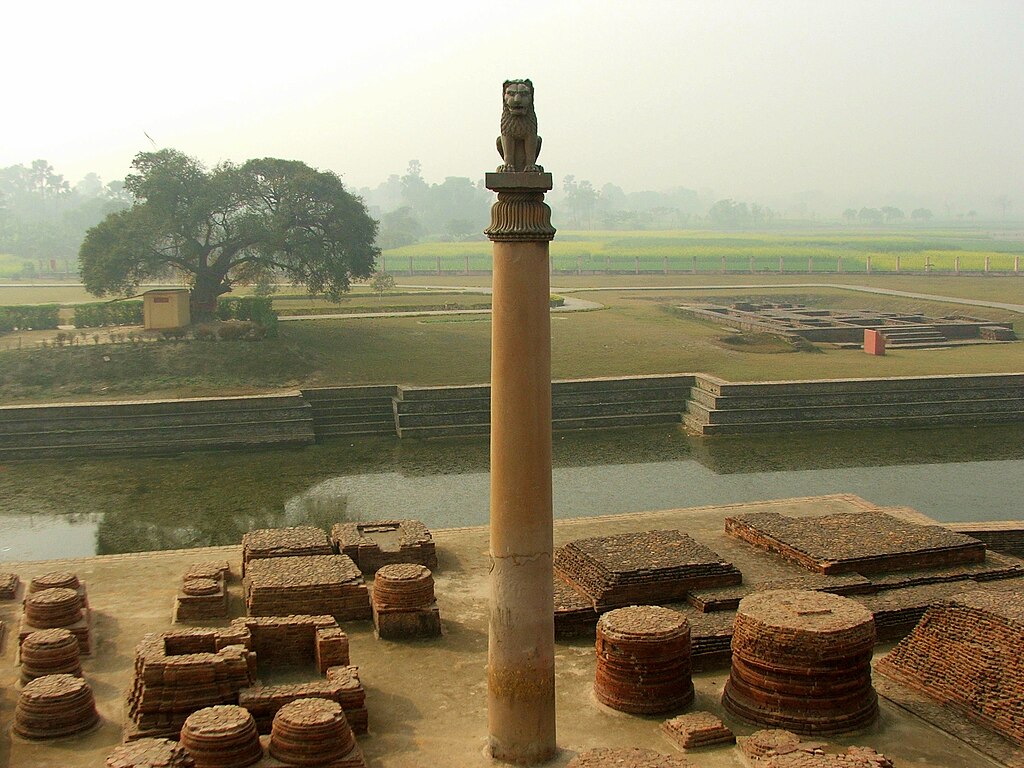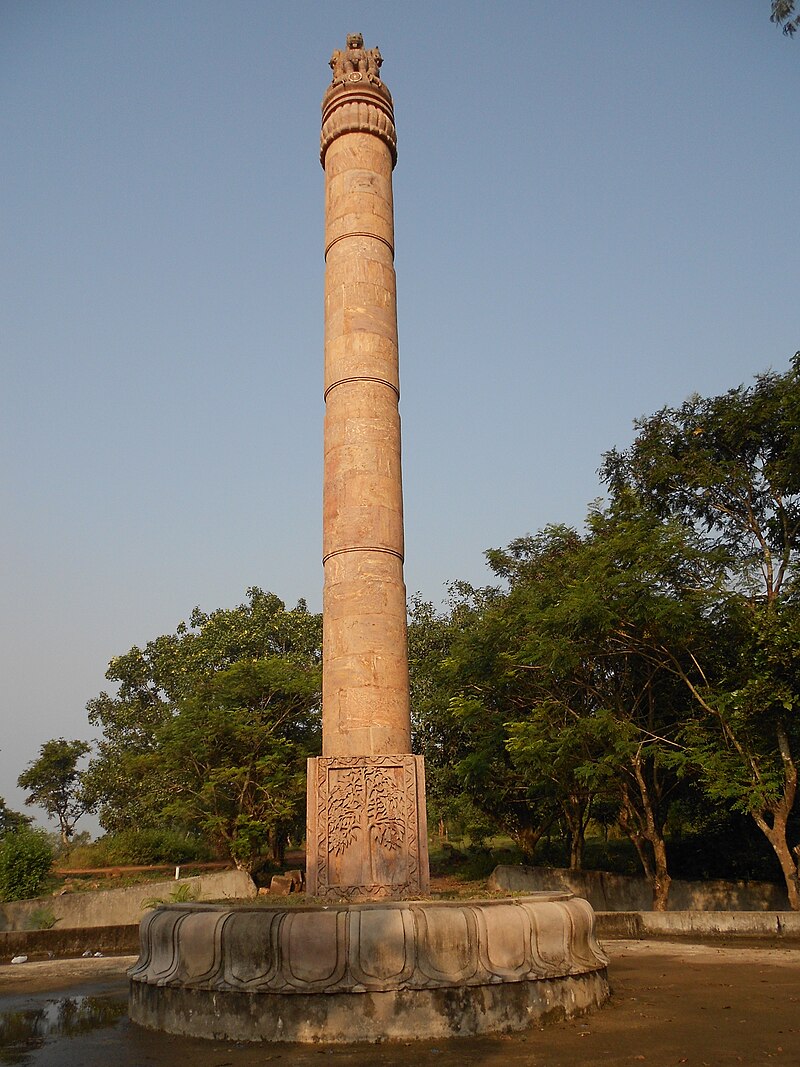Stambha is a column with cosmic connotations, a connection between heaven and earth. Stambhas have been mentioned in early Hindu literature like the Atharvaveda.
Stambhas are of different types; dhwaja stambha, kirtistambha, vijaystambha, deepastambha and the stambhas of King Ashoka.
The dhwaja stambhas are placed in front of the main deity of a temple; kirti/vijay stambhas usually commemorate victories. The Ashoka pillars depict the royal edicts of King Ashoka of the Mauryan dynasty. The deepa stambhas are lit up on festival days at temples.
There is a magnificent vijaystambha ot tower of victory, also referred to as kirtistambha or tower of glory at Chittorgarh Fort in Rajasthan dedicated to Lord Vishnu. Built by Rana Kumbha in 1448 to celebrate his victory over Mahmud Khilji fighting the armies of Malwa and Gujarat. The tower was designed by architect Sutradhar Jaita. The genealogy of the kings of Chittor and names of the architect and carved on the tower.
The image of Padmavati, Jain Goddess is on the top story. The word Allah is also carved in the third and eight stories.
The Ashoka pillars were columns built by Maurya king and emperor Ashoka during 3rd century B.C. These pillars were inscribed with his edicts. Nineteen pillars still exist with the inscriptions. Six of them have lion capitals and some had the bull. The pillars weigh 50 tonnes in weight and were average 15 m in height. They were transported between large distances to their destinations. The pillars were carved out of red-white or buff-coloured sandstone, mostly at Buddhist monasteries after being brought from Chunar and Mathura.

Ashoka pillar, 3rd century B.C.,Vaishali(without edict), Bihar.
By Bpilgrim (talk · contribs) – Own work, CC BY-SA 2.5, https://commons.wikimedia.org/w/index.php?curid=1763101

Ashoka pillar at Allahabad, 1870 image.
By Thomas A. Rust – British Library, Public Domain, https://commons.wikimedia.org/w/index.php?curid=35791625
Ashoka pillar with lion capital near Bhubaneshwar,3rd century B.C.,Odisha.
By Amit Bikram Kanungo – my digital camera, Public Domain, https://commons.wikimedia.org/w/index.php?curid=21228830
The Ashoka pillar of 13 m height, at Ferozeshah Kotla at Delhi was originally at Topra in Ambala from where it was brought and reinstalled at Delhi by Feroze Shah.



Vijay stambh, 15th century, Chittorgarh, Rajasthan.
By Praxipat (Own work) [CC BY-SA 4.0 (http://creativecommons.org/licenses/by-sa/4.0)%5D, via Wikimedia Commons
At the Virupaksha temple at Pattadakal in Karnataka is a victory pillar with inscriptions from the eighth century. The inscription relates the victory of Vikramaditya II of the Badami Chalukya over the Pallavas of Kanchipuram.

Victory pillar with inscriptions, 8th century, Pattadakal, Karnataka.
By Dineshkannambadi at English Wikipedia, CC BY-SA 3.0, https://commons.wikimedia.org/w/index.php?curid=4725456
A brahma stambha stands in front of the Parsvanatha Basti on top of the Chandragiri Hill at Sravanabelogola in Karnataka’s Hassan district. The temple was built in the 11th century and is called Kamata Pasrvanatha Basti.The image of Parsvanatha stands on a lotus pedestal. Lord Parsvanatha is the 23rd Jain Tirthankara and who had an encounter with his enemy Kamata. In late 17th century a manasthambha, also referred to as Brahmastambha facing the temple, 65 feet in height was erected.

Brahmastambha, 17th century,Hassan, Karnataka.
By HoysalaPhotos – Own work, CC BY-SA 3.0, https://commons.wikimedia.org/w/index.php?curid=21740722
The Kolaramma temple is dedicated to Goddess Parvati worshipped as Kolaramma. She is the presiding deity of Kolar in Karnataka. It was built 1000 years ago. by the Cholas. Ornately carved statues from granite stone, lend splendour to the temple which the Maharajas of Mysore used to visit regularly. The second deity at the temple is Chellamma who protects from scorpion-bites. The Hundi of the temple is believed to have a large hole dug into the earth from where one can still hear the sounds of the coins collected over hundred of years.

Dhwajastambha, Kolaramma temple, Kolar, Karnataka.
By Gautamoncloud9 – Own work, CC BY-SA 3.0, https://commons.wikimedia.org/w/index.php?curid=21526497
In the Hutheesing Jain temple at Ahmedabad,Gujarat which was built in 1848 dedicated to the 15th Jain Tirthankara,Dharmanatha. Hutheesing was a rich trader who helped traders by building the temple so that they could be engaged in work during drought which lasted two years. Designed by Premchand Salat, the main building is double storied. The temple houses 11 deities and an additional 52 shrines. The temple has a manastambha or a column of honour.

Manastambha,Hutheesing Jain Temple
By Vaishal Dalal – Own work, CC BY-SA 3.0, https://commons.wikimedia.org/w/index.php?curid=17907102

Deepastambha, Harsiddhi Mata Temple, Ujjain.
By Gyanendra_Singh_Chauhan (http://www.panoramio.com/photo/41416750) [CC BY 3.0 (http://creativecommons.org/licenses/by/3.0)%5D, via Wikimedia Commons
The Shantadurga or Santeri temple near Panjim in Goa is dedicated to Goddess Shantadurga who is believed to have mediated to stop the quarrel Between Lord Shiva and Lord Vishnu of the Hindu trinity. The temple was built during the reign of King Shahu, grandson of Shivaji in the 18th century between 1713 to 1738. The temple had undergone many modifications and Neo-classical architecture can also be seen. On the left side of the courtyard is a deepastambha which is lit up with oil lamps on festival days.

Deepastambha,Shantadurga temple, 18th century, Goa.
By Netguru – Own work, CC BY-SA 3.0, https://commons.wikimedia.org/w/index.php?curid=21127897
References :
- wikipedia.com
- indiathatwas.com
Posted by :
Soma Ghosh
© author

